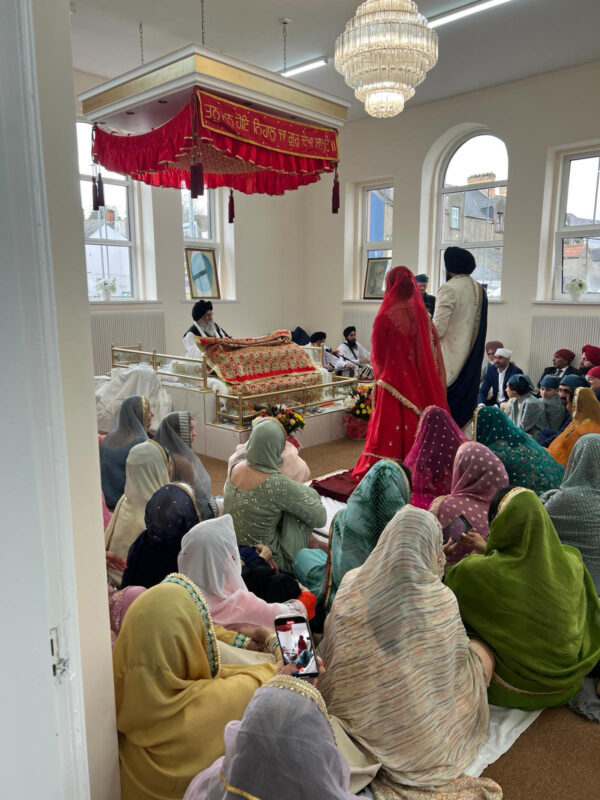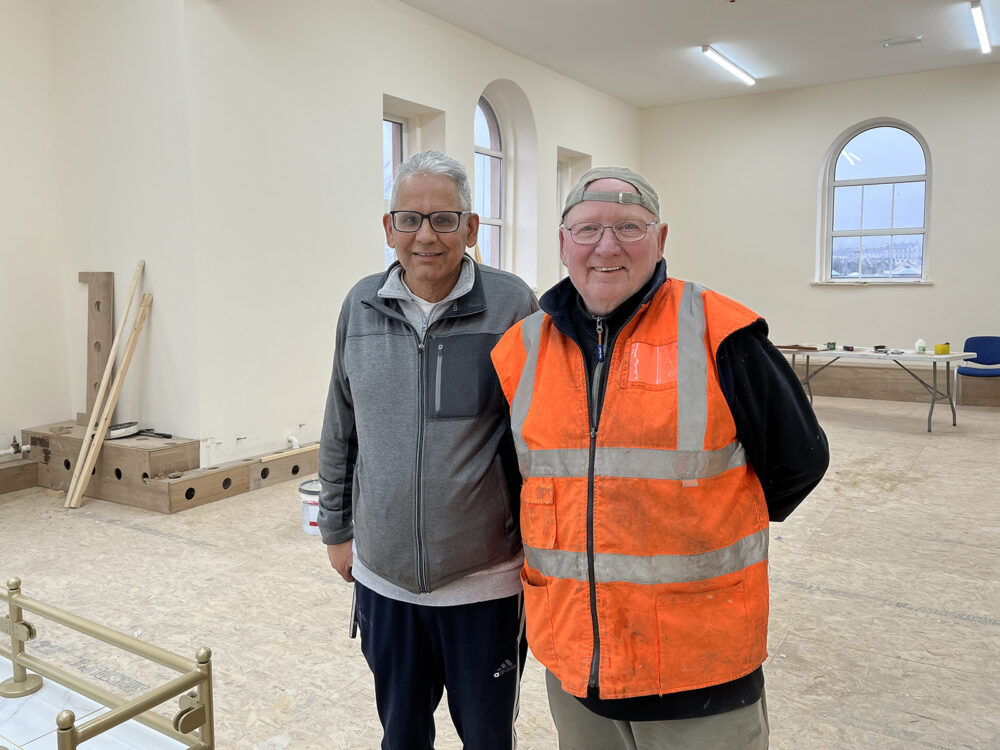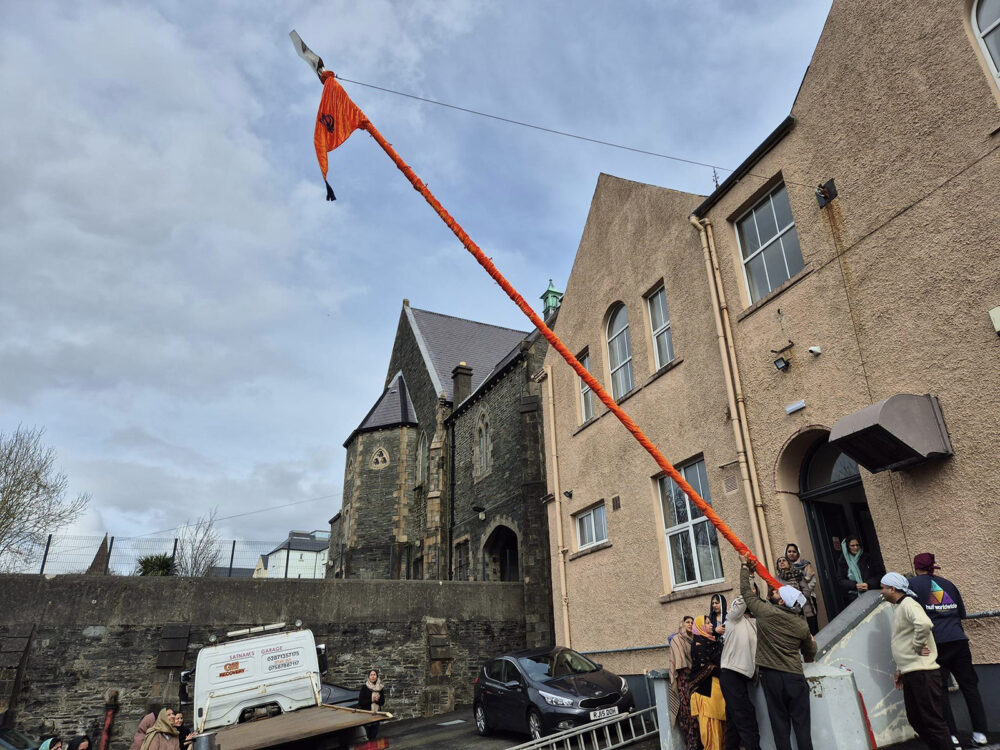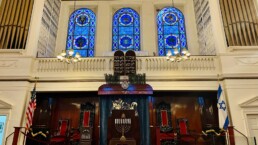In Northern Ireland, a Long-Awaited Gurdwara Opens with a Wedding
LONDONDERRY, Northern Ireland (RNS) — On a cloudy fall day in 2021, about 100 people were praying in Derry’s only Sikh temple when smoke suddenly choked the prayer hall. Worshippers covered their mouths and noses and ran outdoors as flames consumed each room. Amerjit Singh, the president of the Northern Ireland Sikh Association, made sure that everyone was safely outside before running back inside the burning building to rescue the Sikh Holy Scripture known as the Guru Granth Sahib.
On Thursday (April 11), after years of renovations — completed in the spirit of “sewa,” the Sikh principle of selfless service — the temple, known as a gurdwara, reopened with a joyful wedding celebration, welcoming worshippers of all faiths and backgrounds once again. The multistory beige building, resting on a sloping road near the eastern bank of the River Foyle, bears a long history: An old sign indicates it was constructed in 1915, and a newer one introduces it as the Sikh Cultural Centre established in 1995. Jimmy Singh, a longtime worshipper at the gurdwara, says the reopening feels like “the light at the end of a long, long, tunnel.”
Although everyone, including the Guru Granth Sahib, was physically safe after the gurdwara fire, Sikhs in Derry mourned the loss of their beloved temple. The space where they convened at least once a week to pray, sing, eat and serve each other through sewa had become a shell of a structure. The gurdwara leadership determined at the time that it would stay closed until renovations were completed.
In the meantime, Derry’s Sikhs gathered in each others’ living rooms and kitchens to continue their weekly Sunday prayers and the tradition of “langar,” the free meal gurdwaras offer to any visitor without question. The gurdwara was one of two in Northern Ireland and the primary place of worship for Sikhs all over the country as well as for other minority religions, like Hindus, who don’t have a nearby temple of their own.

In the gurdwara’s absence, families were forced to hold funerals in their homes for elderly relatives who died of COVID-19. Hosting weddings and other communal festivities, too, felt incomplete without the gurdwara. Sitting cross-legged on floral carpets with the Guru Granth Sahib propped on a piece of furniture, the community managed to continue gathering and worshipping, all the while eagerly waiting to return to the new building.
It was like decades ago, some recalled, when only a few Sikh families lived in Derry. In those days, they could easily gather in each other’s homes. But since then, the Sikh population in Northern Ireland has grown from a few dozen to just shy of 400, according to the 2021 Census — a number no one’s living room could fit.
“On my way to work, I always drove past and stopped for 30 seconds outside,” said Jimmy Singh of the gurdwara. The space, he said, always brought him a sense of peace and meaning, even when he couldn’t go in. “I just can’t wait to come here every Sunday,” he said.
“It’s a lifeline for older people,” said Kalbinder Kaur, a trustee of the Sikh Association. The gurdwara’s closure, she said, exacerbated the loneliness and isolation of the elderly, who found comfort in the shared language and culture of the Sikh community.
Although the Sikh community has struggled without the gurdwara, Amerjit Singh says the fire may have been a blessing in disguise. The cause of the incident has not been officially determined, but he suspects it was faulty wiring in a building that’s over a century old. The damage revealed dry rot in the walls and floors of the building that could have compromised its structural integrity. Plus, the fire was an opportunity to rebuild the gurdwara to better accommodate the needs of the community.

About a month before the reopening, Amerjit and Jimmy Singh, who are cousins, stepped onto a brand-new elevator platform, clutching the railings. “It’s just been commissioned today,” said Jimmy Singh with excitement. “It’s our first time using it.” He pressed a button, and a soft whirring sound filled the echoing space as the platform smoothly drifted toward the lower level. The elevator for the elderly and disabled is one of the newest additions to Derry’s gurdwara.
Around them, the building buzzed with activity. Sawdust covered the floors, while ladders and tools lay scattered around the building. Volunteers from all walks of life and a number of faiths — Irish Catholic, Irish Protestant, Irish Sikh and Indian Sikh — paced in and out of rooms, scrubbing countertops and drilling into planks of wood. A group of men, some wearing turbans and others with buzz cuts, carried building materials down the staircase and through a doorway as Irish rock music reverberated upstairs. In a city with a long history of religious conflict, the intermingling of cultures and religions in the gurdwara epitomizes Amerjit Singh’s belief that welcoming others is the “single most important part of Sikhism.”
As he strolled around the gurdwara surveying the progress, he listed off the many people, from the architect to the construction workers, who helped rebuild the gurdwara for free or for a discount as an act of sewa. One woman wearing heavy-duty gloves introduced herself as a former employee of his who has volunteered her afternoon to help out at the gurdwara. A carpenter measuring wood in the prayer hall said he has been doing business with the Sikh community for 30 years. Gurdeep Singh and Samser Singh (no relation), two university students from the Punjab region of India who had met for the first time that morning, spent the day at the gurdwara doing sewa, lifting heavy materials side by side as if they’d been working together for years.
Gurdeep Singh, another Sikh man from India who has now lived in Ireland for several years and is not related to the others, said he is looking forward to the prayer, the langar and, of course, the gossip. “We feel very good when we come here,” he said. “We feel relaxed.”
The community is also largely united by their support for the Sikh farmers’ protests in India. Through Khalsa Aid, Derry’s Sikhs send money for food, clothing and medicine for the farmers, who, they believe, are being smeared and targeted by the Indian government. The gurdwara also donates funds to local initiatives. “Sikhs are givers,” said Jimmy Singh. “Baba Guru Nanak, the founder of Sikhism, was a giver, and we want to follow that tradition in our hearts.”
The new building is tech-savvy and accessible. While Sikhs traditionally sit on the floor for langar and prayer, the gurdwara will have benches for the elderly and others who have trouble sitting cross-legged. An expertly planned opening near the kitchen allows volunteers to easily transport groceries inside from a car, reducing the intense prep work for langar, during which volunteers serve hearty meals of daal, roti and prasad to hundreds of people at a time. The building is more insulated and energy-efficient, critical in Northern Ireland’s soggy year-round weather. A guest room with three beds in the basement is built to host Sikh musicians, called ragis, and other visitors.

On March 24, about two weeks before the reopening, a group of Sikh worshippers hoisted the Nishan Sahib, a triangular orange flag with a dark-blue khanda symbol. The crowd stood barefoot around the silk-wrapped flagpole. One woman began a melodic prayer, and others closed their eyes in meditation and joined in.
A wedding seemed the perfect celebration to open the new gurdwara. Amongst traditional Punjabi music and sparkling chandeliers hanging from the newly finished ceiling, over 300 people gathered to celebrate the newlyweds — a non-Sikh Irish bride and a Sikh groom — with music, prayers and a langar of pakora, three different types of curries, gulab jamun and laddoo. Men wore suits and patkas, while women wore a rainbow of elegant salwar kameez.
“It was full of color,” said Amerjit Singh, after the daylong ceremony. “I saw a vision of a much more diverse Northern Ireland in the gurdwara today.”
First published on Religion News Service.
A Sacred Moment Between Rest and Work: Havdalah at a Modern Orthodox Synagogue
NEW YORK — In 1941, a group of 61 Jewish refugees from Luxembourg arrived in New York City. Narrowly escaping the impending doom of Nazi-orchestrated extermination camps in East Germany, the group fled to Lisbon, then sailed across the Atlantic to seek refuge in the United States.
Despite pressures to assimilate fully into American culture, the refugees clung to their traditions, their community and their faith. The rabbi who coordinated their escape, Dr. Robert Serebrenik, found a half-completed Unitarian Church on the Upper West Side at 550 W 110th St. The church construction had been abandoned, and Serebrenik saw an opportunity. He purchased it and named the new synagogue Ramath Orah, “mountain of light” in Hebrew — a direct translation of Luxembourg, the home they had left behind.
In the looming space, the community gathered to pray, sing and eat. They rested from Friday evening to Saturday evening for Shabbat, and around sundown on Saturday, held maariv and havdalah to prepare for the week of work ahead.
Today, more than 80 years after the founding of the synagogue, those traditions continue. As the sun was setting on a recent Saturday evening, a 16-year-old named Ziv Siegel lights a thick white candle for Havdalah. Organ pipes from the unfinished church line the walls behind him, and the last rays of sunlight filter through a circular yellow and blue stained glass window gifted to the congregation by the government of Luxembourg.
Ziv begins to sing, and the small congregation who had gathered in the room, men and women separated by a cloth divider, joins in.
Baruch atah, Adonai Elohenu
Melech haolam
Borei p’ri hagafen
The melody is chillingly beautiful and drifts up to the high arching ceilings of the synagogue. The candlelight flickers on Ziv’s eyelids as he sings, his head bent down.
Congregants gather around him to observe the candlelight on their hands, flipping their palms back and forth and bending their fingers as if to beckon the light. The motion is a reminder of the light in the week and in life. To Ziv, this marks a departure from Shabbat, because lighting a candle is work that is forbidden during the prior day.
Ziv drinks the cup of wine, which seems to actually be grape juice, as a metaphor for the sweetness of the day of rest. Congregants sniff white mesh drawstring pouches filled with spices — one person says it’s cinnamon and cloves, another has no idea but says it smells nice — which fill the nostrils with a rich, earthy essence. During Shabbat, according to Ziv, the Talmud says a new soul comes to the body — a soul that brings peace, calm and rest. During havdalah, that soul departs. In order to rejuvenate the dormant souls tasked to work throughout the week, congregants smell the decadent spice. So begins the week ahead.
After Havdalah, Ziv and his father, Jonathan Siegel, say that the ceremony is a separation between holy time and the everyday. Ziv, who commutes an hour to an Orthodox Jewish school in Riverdale every day, says he feels deeply connected to the synagogue and the community. “It’s a lot of pressure,” he says about leading Havdalah. But the ritual, a quiet acknowledgement of the dichotomy of work and rest, peace and chaos, has given congregants over the decades a moment to acknowledge the passage of time, from the refugees who fled certain death in Europe to young practitioners like Ziv who are keeping their memories alive.


